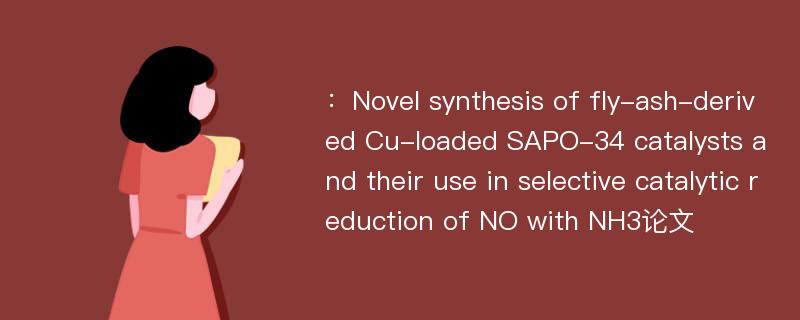
本文主要研究内容
作者(2019)在《Novel synthesis of fly-ash-derived Cu-loaded SAPO-34 catalysts and their use in selective catalytic reduction of NO with NH3》一文中研究指出:A combined acid–alkali hydrothermal method was used to prepare fly ash –derived SAPO-34 molecular sieves from a thermal power plant in Inner Mongolia(China). The specific surface area of the prepared fly-ash-derived SAPO-34 molecular sieves was 579 m2g-1, the total pore volume was about 0.27 cm3g-1, and the pore size was 0.56 nm; the molar ratios of Al2O3:P2O5:SiO2 were 1:0.86:0.45. Cu/SAPO-34 catalysts were prepared by impregnation of low-cost fly-ash-derived SAPO-34 molecular sieves as a support and tested in selective catalytic reduction with NH3(NH3-SCR). Powder X-ray diffraction(XRD), N2 adsorption–desorption, X-ray photoelectron spectroscopy(XPS), H2 temperatureprogrammed reduction(H2-TPR), NH3 temperature-programmed desorption(NH3-TPD), electron paramagnetic resonance(EPR), nuclear magnetic resonance(NMR), X-ray fluorescence analysis(XRF) and scanning electron microscopy(SEM) were used for catalyst characterization and investigation of the relationships between the catalyst structure and the catalytic activity. The actual silica:alumina ratio of the molecular sieves did not increase with increasing Cu loading, indicating that increasing the Cu loading does not change the original structure of the SAPO-34 molecular sieves. The XRF and NMR results showed that replacement by Cu results in more Si islands. The molecular sieve acidity decreased because of the increased number of Si islands. The NH3-TPD results showed that for the Cu/SAPO-34 catalysts there was a low correlation between the low-temperature activity and the amount of acidic sites. SCR activity is closely related to the location of Cu. The 4.47 Cu/SAPO-34 catalyst has the highest isolated Cu2+ showed the highest NH3-SCR activities(> 90%) at 250–350°C. This work opens up new avenues for recycling fly ash formed in coal-fired power plants(reducing environmental pollution) and developing low-cost SCR catalysts for NOx pollution control.
Abstract
A combined acid–alkali hydrothermal method was used to prepare fly ash –derived SAPO-34 molecular sieves from a thermal power plant in Inner Mongolia(China). The specific surface area of the prepared fly-ash-derived SAPO-34 molecular sieves was 579 m2g-1, the total pore volume was about 0.27 cm3g-1, and the pore size was 0.56 nm; the molar ratios of Al2O3:P2O5:SiO2 were 1:0.86:0.45. Cu/SAPO-34 catalysts were prepared by impregnation of low-cost fly-ash-derived SAPO-34 molecular sieves as a support and tested in selective catalytic reduction with NH3(NH3-SCR). Powder X-ray diffraction(XRD), N2 adsorption–desorption, X-ray photoelectron spectroscopy(XPS), H2 temperatureprogrammed reduction(H2-TPR), NH3 temperature-programmed desorption(NH3-TPD), electron paramagnetic resonance(EPR), nuclear magnetic resonance(NMR), X-ray fluorescence analysis(XRF) and scanning electron microscopy(SEM) were used for catalyst characterization and investigation of the relationships between the catalyst structure and the catalytic activity. The actual silica:alumina ratio of the molecular sieves did not increase with increasing Cu loading, indicating that increasing the Cu loading does not change the original structure of the SAPO-34 molecular sieves. The XRF and NMR results showed that replacement by Cu results in more Si islands. The molecular sieve acidity decreased because of the increased number of Si islands. The NH3-TPD results showed that for the Cu/SAPO-34 catalysts there was a low correlation between the low-temperature activity and the amount of acidic sites. SCR activity is closely related to the location of Cu. The 4.47 Cu/SAPO-34 catalyst has the highest isolated Cu2+ showed the highest NH3-SCR activities(> 90%) at 250–350°C. This work opens up new avenues for recycling fly ash formed in coal-fired power plants(reducing environmental pollution) and developing low-cost SCR catalysts for NOx pollution control.
论文参考文献
论文详细介绍
论文作者分别是来自Green Energy & Environment的,发表于刊物Green Energy & Environment2019年04期论文,是一篇关于,Green Energy & Environment2019年04期论文的文章。本文可供学术参考使用,各位学者可以免费参考阅读下载,文章观点不代表本站观点,资料来自Green Energy & Environment2019年04期论文网站,若本站收录的文献无意侵犯了您的著作版权,请联系我们删除。
